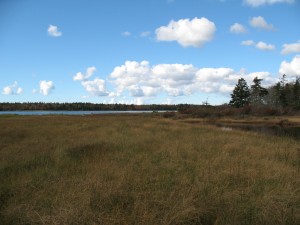Nature Conservancy of Canada Protects Important Nova Scotia Coastal Habitat for Waterfowl and Rare Plants
 Roberts Island, Nova Scotia (April 15, 2016) – As part of National Wildlife Week, the Nature Conservancy of Canada is pleased to announce it has finalized the acquisition of a 20 hectare (50-acre) site on Roberts Island, located on the west side of Lobster Bay in Yarmouth County, Nova Scotia.
Roberts Island, Nova Scotia (April 15, 2016) – As part of National Wildlife Week, the Nature Conservancy of Canada is pleased to announce it has finalized the acquisition of a 20 hectare (50-acre) site on Roberts Island, located on the west side of Lobster Bay in Yarmouth County, Nova Scotia.
The property contains critical salt marsh used year-round by black ducks and seasonally by long-tailed duck and green-winged teal.
The salt marsh is also home to the Eastern baccharis (Groundseltree), a rare plant in the group of Atlantic Coastal Plain Flora. Lobster Bay is the only place in Canada where Eastern baccharis is found. There are 20-30 of these plants on the property, out of a total Canadian population of approximately 3000 plants.
In addition to these ecologically-productive salt marshes, the site also includes coastal forest with black and white spruce and balsam fir trees.
This conservation project was supported by funding from the Government of Canada through the Natural Areas Conservation Program, the Nova Scotia Crown Share Land Legacy Trust, the United States Fish and Wildlife Service under the North American Wetlands Conservation Act, and the Nova Scotia Fisherman company, along other local donors and supporters.
A portion of this project was donated to the Nature Conservancy of Canada under the Government of Canada’s Ecological Gifts Program. This program provides enhanced tax incentives for individuals or corporations who donate ecologically significant land.
Quotes:
“The Nature Conservancy of Canada is pleased to be able to protect this valuable coastal habitat on the southern tip of Nova Scotia. We would like to thank our private and government donors for their support. There are many more ecologicallly significant sites in Nova Scotia that NCC would like to preserve, and we invite interested landowners to contact us to learn more about conservation options for their land.”
Craig Smith, NCC Program Director in Nova Scotia.
“As we celebrate National Wildlife Week, the Government of Canada is pleased to work with the Nature Conservancy of Canada to protect this important marshland habitat in Nova Scotia. Protecting coastal lands like these also benefits local communities by helping to mitigate the impacts of storms and rising sea levels associated with climate change.”
Honourable Catherine McKenna, Minister of Environment and Climate Change
“Through the Natural Areas Conservation Program and the Ecological Gifts Program, the Government of Canada is working to protect this important animal habitat and conserve the natural beauty of the West Nova region for generations to come.”
Colin Fraser, MP West Nova
Facts:
- Other species on these lands include white tailed deer, woodpeckers, songbirds, common goldeneye, surf scoters and Canada geese.
- Atlantic Coastal Plain Flora (ACPF) are a group of flowering plants, shrubs and herbs that are at their northern limit of their range in the Canadian distribution. Of the 90 plants in ACPF, 11 are legally listed under the Species at Risk Act. For more information visit: http://www.registrelep-sararegistry.gc.ca/virtual_sara/files/plans/rs_atlantic_coastal_plain_flora_final_2010_e1.pdf
- This project was completed under the auspices of the Eastern Habitat Joint Venture (EHJV). Since 1989, EHJV partners have been delivering wetland-habitat conservation projects in Eastern Canada’s six provinces as part of the continental North American Waterfowl Management Plan. For more information visit www.ehjv.ca.
Learn More:
The Nature Conservancy of Canada is the nation’s leading land conservation organization, working to protect our most important natural areas and the species they sustain. Since 1962 NCC and its partners have helped to protect more than 1.1 million hectares (over 2.8 million acres), coast to coast. The Nature Conservancy of Canada has conserved over 33,000 acres in Nova Scotia. For more information visit: www.natureconservancy.ca/ns.
The Government of Canada’s Natural Areas Conservation Program (NACP) is a unique public-private partnership led by the Nature Conservancy of Canada. To date, $345 million has been invested in the NACP by the Government of Canada to secure our natural heritage. Additionally, more than $400 million in matching contributions has been raised by NCC and its partners.
To learn more about the Ecological Gifts Program, please visit http://www.ec.gc.ca/pde-egp/.
Visit: www.natureconservancy.ca/ns
Follow us on Twitter: twitter.com/NCC_CNC
Become a fan on Facebook: www.facebook.com/natureconservancy.ca
Media Contact:
Kathryn Morse, Director of Communications-Atlantic Provinces, Nature Conservancy of Canada, 1-866-319-5985 Kathryn.Morse@natureconservancy.ca
